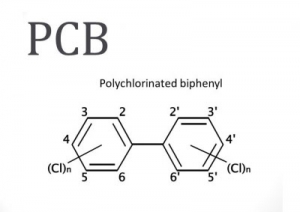Polychlorinated biphenyls (PCBs)
Polychlorinated biphenyls are recognized as very important environmental pollutants. PCBs are among the most environmentally persistent of organic compounds; although their solubility in water is very low, they are readily soluble in nonpolar solvents and can accumulate in fats. Mixtures of a large number of PCBs isomers are used in the heavy electrical equipment industry (e.g. in power capacitors and high-voltage transformers), mechanical engineering (e.g. as inflammable liquids for heat transfer, in hydraulic fluids and in lubricants for compressors) and in the chemical industry (e.g. the production of synthetic varnishes, dyestuffs and plastics). The world-wide trade names of PCBs include Delor (Czechoslovakia), Aroclor (USA), Clophen (Germany), Kaneclor (Japan), and Savol and Sovtol (USSR). In response to a growing concern about rising levels of PCBs in the environment from diffuse sources, their accumulation in biota, and uncertainty about their toxic effects, the production of polychlorinated biphenyls was restricted in 1971, and successive controls placed on its use and disposal. The main concern is that, once in the natural environment, they cannot be recovered or removed.
In surface waters, PCBs occur at concentrations from 1.108 to 1.104 mg per litre. Polychlorinated biphenyls have a high capacity for accumulation in the bottom sediments and in aquatic organisms for which the bioaccumulation coefficient is from 103 to 105, depending on the fat content.
PCBs present a very difficult ecotoxicological problem; there are 209 individual PCBs, each one with different toxicological properties. Toxicity tests are carried out on commercial formulations which are identified by the extent to which they are chlorinated, and not by the specific PCBs that they contain. This makes it difficult to assess their toxicity in the environment, because differential uptake of the individual compounds leads to a different ratio being found in organisms when compared to that in the tested formulations. Therefore, any assessment of the toxicity of PCBs can be made only in general terms on the basis of tests with commonly used formulations.
PCB formulations are very toxic to extremely toxic to fish, especially in their early developmental stages; their 48 hour LC50s are below 1 mg per litre.
Of the various toxic actions of PCBs reported, they have been found to adversely affect the enzyme systems within the microsomal fraction of the liver. If fish are exposed for a long time to low sublethal PCBs levels, the compounds accumulate in the body and can cause, mainly in the fry, deformities in the skeleton, damage to the skin and fins (the fins disintegrate), to the parenchymatous organs (mainly in the liver where hypertrophy, local dystrophy, and necrobiotic to necrotic changes can occur), and to the gonads. These effects can cause a subsequent mortality during hatching, high mortality of early fry and an increased occurrence of different deformities among the survivors.
The maximum admissible PCBs concentrations in water range from 1.10-6 to 5.10-6 mg per litre for salmonids and from 2.10-6 to 1.10-5 mg per litre for cyprinids (Mattheis et al., 1984). Lower admissible concentrations are recommended during hatching and rearing of the early stages of the fry. However, analytical measurement of these concentrations in solution may be difficult; also, a significant proportion of the uptake of PCBs will be from the food. Analysis of fish tissue will give an indication of the degree of exposure, but the concentrations found must be correlated with the tissue fat content. Where significant amounts occur, the analysis should identify and quantify a number of key individual PCBs for an expert evaluation of the potential hazard.

